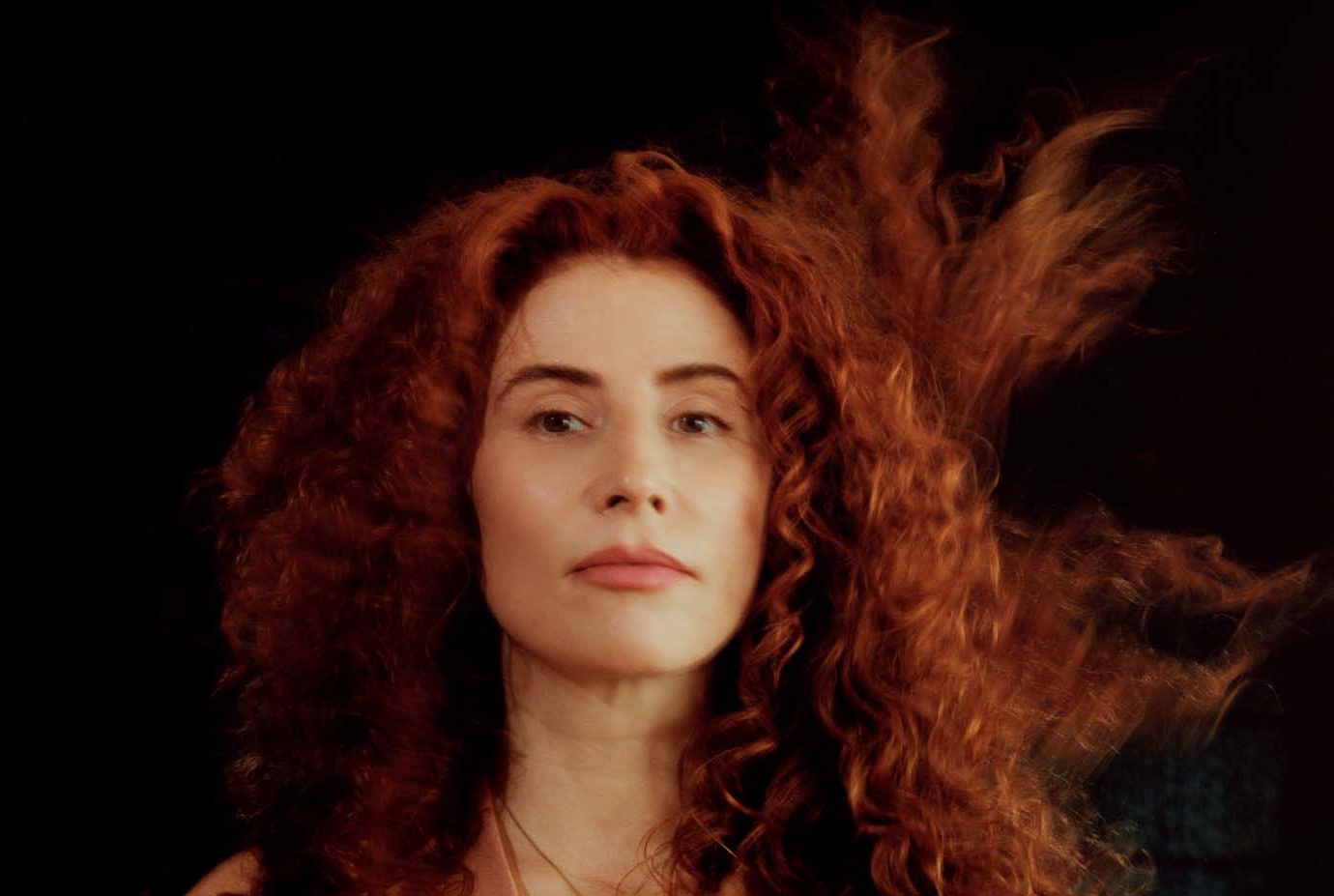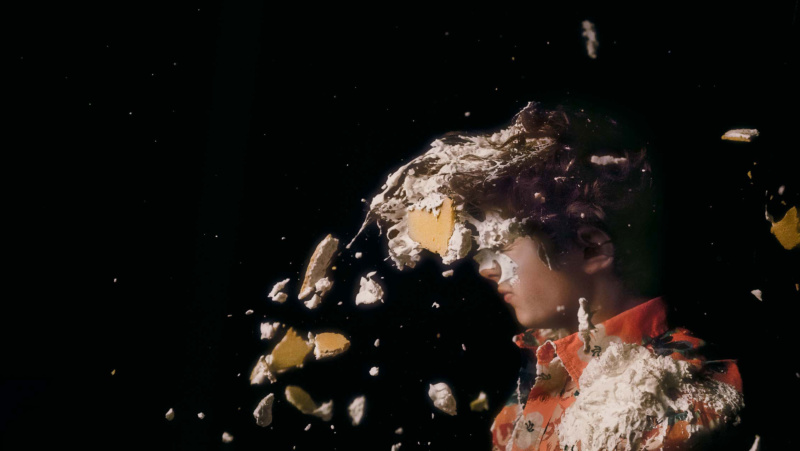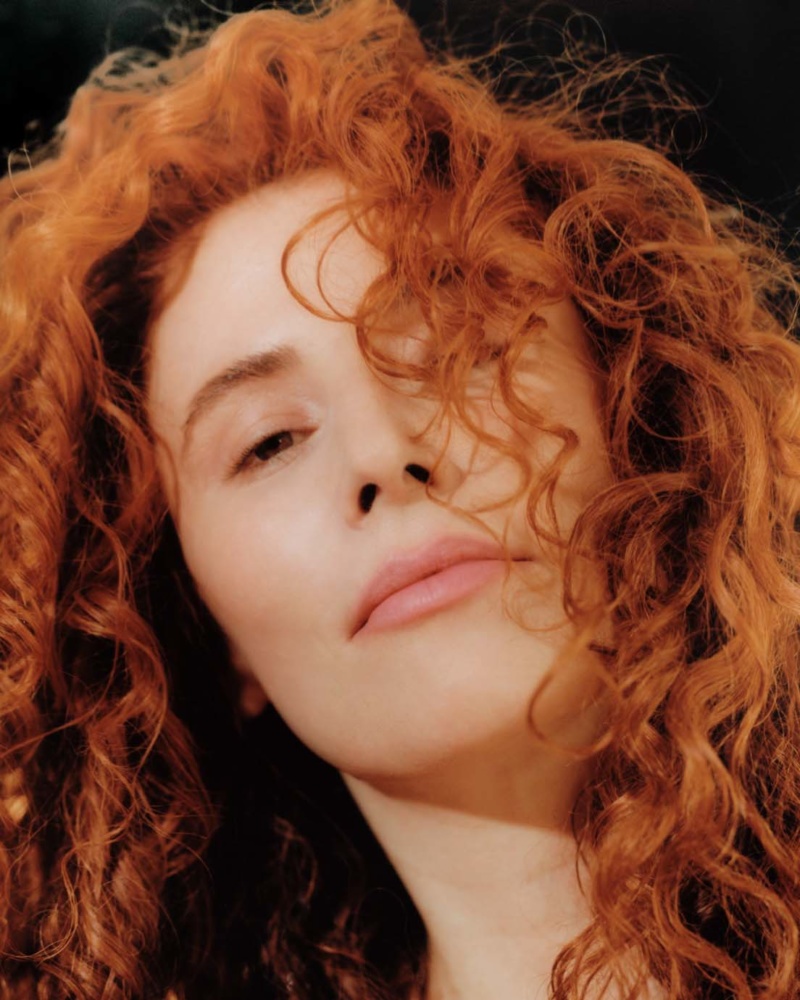
In the early minutes of Honey Boy, a pair of rhyming images bridge the two time frames that will go on to occupy the movie. The first, chronologically identified as 2005, shows angsty twenty-ish movie star Otis (Lucas Hedges) attempting to perform an acrobatic stunt on the set of an elaborate-looking action production. The second, 1995, places a decade- younger, curly-haired Otis (Noah Jupe) against a black background, bracing for impact as a pie careens toward his face. Taken together, these two tableaux—their connotations charting an abstract evolution between Disney Channel–age comedic hijinks and Transformers-level blockbuster gadgetry—crisply summarize the rocky career transitions of Shia LaBeouf, who wrote the screenplay for Honey Boy and stars as James Lort, Otis’s abusive, ex-rodeo-performer dad (a character based on LaBeouf’s own father.) But one of the more surprising elements of Honey Boy is how well this uncommonly personal material matches with the movie’s director— the music-video auteur, commercial artist and documentarian Alma Har’el—here making a supposed departure into Hollywood portraiture for her first fiction feature. Har’el’s work, however, has long dabbled in the ruminative characteristics that define Honey Boy: multiple perspectives, intense psychological scrutiny, grand flights of imagination.
“We have the tendency to look at everything in a binary way. We say, ‘OK, this is documentary, this is scripted.’ And my tendency has always been to be non-binary about those things, to not really put them in those boxes,” Har’el said in a phone interview in September. Her warmly feted Bombay Beach (2011), which won Best Documentary Feature at Tribeca Film Festival, laid the groundwork for this ethos by treating its real-life subjects—the residents of a California seaside town that blossomed in the creaky optimism of 1950s-era development but now appears seemingly lost to time—in ways strikingly different from the usual talking-head doc. She opens with narration from Red, a lonesome old- timer whose gravelly voice and twilight-years reflections—“I’ll just bet my bottom dollar, it was beautiful to you to see your dad give your mom a hug and a kiss”—intone from on high with nothing less than actorly force. Har’el also engages other key personalities—including Benny, a boy dealing with a raft of behavioral medications— in choreographed dancelike sequences, setting their fanciful movements to Bob Dylan or original music by Zach Condon of the band Beirut. “I’ve treated every person I’ve filmed like a collaborator. I didn’t try to trick them into thinking there was no camera,” Har’el explains. Even as she sufficiently evokes the hour-to-hour specifics of her characters’ lives—Benny’s numerous visits to hospitals and doctors’ offices, Red’s plaintive drives to nearby Indian reservation land to load up on untaxed cigarettes—she insists on pushing beyond the everyday.

Har’el’s follow-up doc, LoveTrue (2016), marked not only a furthering of her spontaneous evocation of real lives but also the start of her professional collaboration with LaBeouf. The actor, impressed by Bombay Beach, reached out to Har’el and ended up financing and executive- producing LoveTrue. It follows the romantic and family lives of a trio of characters—the respective settings are Alaska, Hawaii and New York—but does so in a manner that forecasts the therapeutic quality of Honey Boy. In one sequence, Blake, a dancer in an Alaska nightclub who’s dating a man with a rare bone disease named Joel, recalls episodes of bullying from her childhood. Again, Har’el rejects straightforward testimony, preferring to visualize Blake’s memories. She situates Blake on a school bus, surrounds her with kids shouting nasty remarks and even has her interact with a younger version of herself. (Occasionally, people wear T-shirts inscribed with designations—like “older Blake”—that explicitly call attention to Har’el’s experimentations with artifice and time.) It was partly this adventure into psychodrama, Har’el recalls, that convinced LaBeouf to share with her the Honey Boy script he’d drafted during a stint in rehab. “When he sent me the script, I kind of realized he’d written it in a way that he can play his dad, and what that would mean,” Har’el says. “It was such an organic way to develop what we started doing in LoveTrue.”
In addition to her feature-length work, Har’el has directed music videos for a variety of bands including Beirut and Sigur Rós—and shot commercials for such brands as Airbnb and Stella Artois. In 2016, she launched Free the Bid, an initiative aimed at disrupting the overwhelmingly male representation of directors in the advertising industry. “At the bidding stage” of a commercial project, the organization’s website explains, “ad agencies typically present three directors” as possible options—often exclusively men. “Advertising is a constant brainwash that we’re under,” Har’el says, offering statistics that say people are “exposed to between 3,000 to 10,000 marketing messages” on a daily basis. “So when you think about how, say, 90% of those are created by white men, you really understand why the culture looks the way it does and feels the way it does to many of us who don’t fall into that category.” According to Har’el, in just the short time since she began the nonprofit, representation numbers for women in advertising have skyrocketed. And now, with the impending launch of Free the Work, she aims to achieve a similar breakthrough in the movie and television industry. Har’el is enthusiastic about the program—which she says will use Spotify-style algorithms to match developing projects with well-suited prospective directors—but remains skeptical even of numbers that indicate more women are being hired. “They’ve been assuming for decades that white men can tell the stories of everybody,” Har’el says. “[Even] now that they’re hiring women and people of color, they definitely only hire them for certain projects.”  One ironic result of Har’el’s advocacy, she says, has been people interrogating her as to why her own movies consider male perspectives in such thoughtful measure. “When I went to do Honey Boy,” Har’el says, “a lot of people were like, ‘Why are you doing a film with male protagonists? Why aren’t you making a film with women?’” But one of the great rewards of Har’el’s work is how exactingly she picks apart— gently but decisively—familiar masculine myths. In an extraordinary sequence in LoveTrue, Will, a charismatic Hawaiian still reeling from the revelation that his son was actually biologically fathered by another man, executes a series of dangerous surfing moves. After, reflecting on his behavior for the camera while still pumping with adrenaline, he boasts erratically, punching trees with triumph but also saying that his feats made him “[think] about dying.” In the next scene, Will, here looking like he just woke up, admits sheepishly to being embarrassed that Har’el caught “one of the darkest moments of my life.” In Bombay Beach, Har’el also captures the dispiriting aspects of the ancient Red, whose font-of-wisdom narration is belied by his racist views and isolationist lifestyle.
One ironic result of Har’el’s advocacy, she says, has been people interrogating her as to why her own movies consider male perspectives in such thoughtful measure. “When I went to do Honey Boy,” Har’el says, “a lot of people were like, ‘Why are you doing a film with male protagonists? Why aren’t you making a film with women?’” But one of the great rewards of Har’el’s work is how exactingly she picks apart— gently but decisively—familiar masculine myths. In an extraordinary sequence in LoveTrue, Will, a charismatic Hawaiian still reeling from the revelation that his son was actually biologically fathered by another man, executes a series of dangerous surfing moves. After, reflecting on his behavior for the camera while still pumping with adrenaline, he boasts erratically, punching trees with triumph but also saying that his feats made him “[think] about dying.” In the next scene, Will, here looking like he just woke up, admits sheepishly to being embarrassed that Har’el caught “one of the darkest moments of my life.” In Bombay Beach, Har’el also captures the dispiriting aspects of the ancient Red, whose font-of-wisdom narration is belied by his racist views and isolationist lifestyle.
And in Honey Boy, LaBeouf’s James represents yet another dark soul—Vietnam veteran, felon, damaging father figure. Har’el pinpoints the man’s contradictions in a stinging gesture aboard a motorcycle, after James picks up Otis from work one day: After Otis sets his head on his dad’s shoulders, James throws his helmet back, jarring the child and spurning even a second of end-of-day comfort. Though James usually executes the logistical demands of his role as a parent—waking his son up for work in the morning, picking him up at night—he just as resolutely fails at the emotional requirements, belittling Otis at many turns. While compelling in its rendering of the experience of the child actor—a shot of Otis hoarding treats from an on-set snack table is particularly sharp—Honey Boy also more essentially offers a sensitive exploration of broken homes and lost souls, something Har’el’s movies have detailed time and again. “All three of my films deal with this generational idea of pain and trauma and love,” Har’el says, “and how they feed into and create these personal mythologies that we wrestle with for the rest of our lives.”










 in your life?
in your life?

